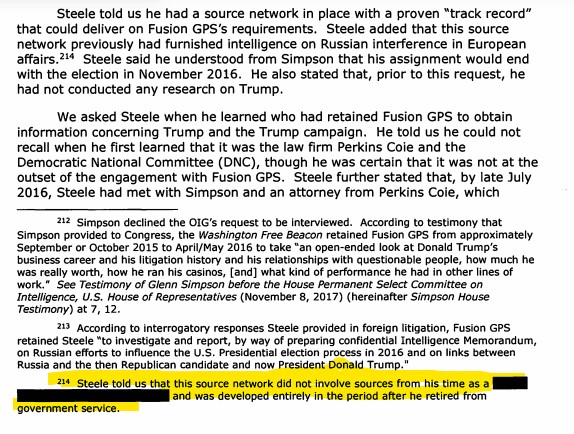Much has been missed, including one significant misrepresentation contained in all four of the Carter Page FISA applications—an inaccuracy even the IG’s team overlooked.
Left-leaning politicians and the press spent more than three years pushing the Russia collusion hoax. Yet, following the inspector general’s release of his 478-page report on Foreign Intelligence Surveillance Act (FISA) abuse, after making quick mention of the top-line findings, the media moved on. As a result, much has been missed, including one significant misrepresentation contained in all four of the Carter Page FISA applications—an inaccuracy even the IG’s team overlooked.
Two passages, separated by more than 50 pages, when read together reveal an eighth significant inaccuracy and omission from the first FISA application, and one repeated in the later three renewals: Steele’s sources and sub-sources were not ones he used or developed during his time with the British intelligence service MI6, contrary to the impression created in the FISA applications.
This detail was dropped in a footnote in the IG report, following this text: “Steele told us he had a source network in place with a proven ‘track record’ that could deliver on Fusion GPS’s requirements. Steele added that this source network previously had furnished intelligence on Russian interference in European affairs.”
The relevant footnote, footnote 214, then read: “Steele told us that this source network did not involve sources from his time as a [redacted] and was developed entirely in the period after he retired from government service.” The redacted language undoubtedly referred to Steele’s British intelligence work.

That Steele’s “source network did not involve sources from his time” with British intelligence proves extremely significant when considered in tandem with the details the IG provided about the FISA application process in general, and the specifics of the Page FISA applications.
The IG report began with a general description of the FISA process, explaining that a proposed application, typically referred to as a “read copy,” is presented to the FISA court. Then the FISA court “will review the read copy, evaluate whether it meets the requirements of the statute, and, through a legal advisor, discuss with the assigned attorney, any issues the legal advisor or judge identified.” This process, the IG noted, “allows FISC legal advisors to have informal interaction with [the National Security Division’s Office of Intelligence], to convey any questions, concerns, or requests for additional information from the legal advisor or judge before a final application is filed.”
In the Page case, the first read copy submitted to the FISA court “contained a description of the source network that included the fact that Steele relied upon a Primary Sub-source who used a network of sub-sources, and that neither Steele nor the Primary Sub-source had direct access to the information being reported.” The read copy “also contained a separate footnote on each sub-source with a brief description of his/her position or access to the information he/she was reporting.”
In response to the read copy, the FISA court’s “legal advisor asked how it was that Steele had a network of sub-sources.” After the Office of Intelligence (OI) attorney “provided additional information to him regarding Steele’s past employment history,” the legal advisor requested that additional information be included in the final application.

The final version of the October 2016 FISA application included the requested description, which again remains redacted, but surely concerns Steele’s prior spy work for the United Kingdom.

But, as highlighted above, the source network Steele relied upon to craft his dossier was not developed or used during his previous life as a British intelligence agent. By stressing Steele’s prior work with MI6 in response to the legal advisor’s questioning of Steele’s network of sources, the DOJ created the false impression that the network of sources that Steele used and relied upon for his dossier were also used and relied upon by the British government.
That the legal advisor not only raised the question about Steele’s access to a network of sources, but then insisted that the FISA application be updated to include information concerning Steele’s prior government position, shows the FISA court placed great significance on Steele’s previous British intelligence work for purposes of assessing the reliability of his source network.
The DOJ’s failure to inform the FISA court that Steele’s sources and sub-sources were privately acquired—or the FBI’s failure to inquire of these facts in light of the FISA court’s query—is yet another significant inaccuracy and omission in the FISA applications.



No comments:
Post a Comment